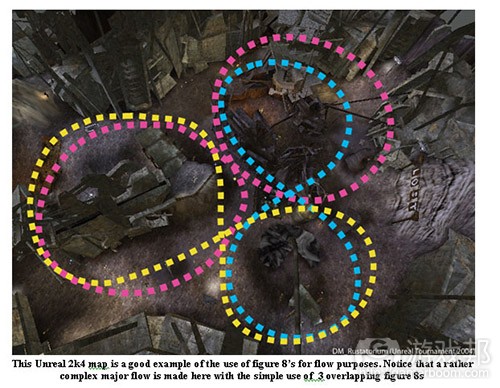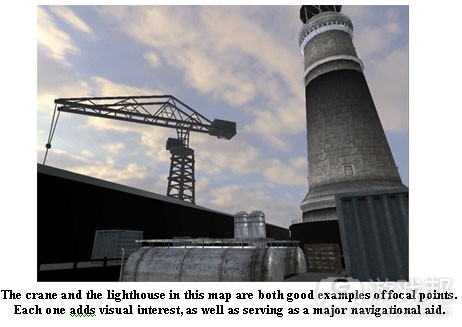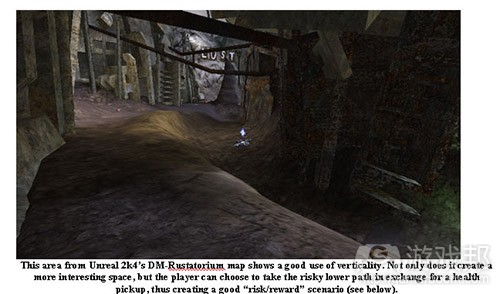万字长文,关于设计FPS多人模式地图方式的探讨
作者:Dodger
选择
Sid Meyer曾说过“游戏是一系列有意义的选择”,对于多人模式游戏设计来说,这一再正确不过了。在单人游戏中设计师利用线性发展,或者只是一般的玩法片段操作等设计工具 来引导玩家。而在多人模式游戏中,玩家只要使用你所提供的工具,就能够持续创造自己的体验。
为此,我们很有必要从这个角度来看待多人模式地图设计:为玩家提供优秀的工具,以便他们创造良好的体验。
当然,这一切听起来显而易见,但还是有许多人误解了这个基本概念,因此我们有必要在此进行阐述。
地形选择
在多人模式FPS地图中为玩家提供有趣选择的一个好方法就是,给予他们多种地形选择。(游戏邦注:例如,墙壁、高地、低地等都属于地形选项)优秀玩家会掌握根据情况来选择 地形的方法。例如,玩家选择比对手更高的地势总是一个更好的主意。这不但可以为其提供更高的射击角度,通常还会提供部分的掩护。现在假设你将高地设置在一个靠近墙体的 地方,那么玩家就必须做出选择:走向高地并获得掩护,还将自己暴露在极易被敌人的炮火击中的空旷之地?
优秀的多人模式设计师总会考虑到地形选择,并尽量为玩家提供更多好选择。
多人路径
在单人模式游戏中,将玩家引向人的游戏所能提供的最佳玩法体验总是有利的。通常,这会导致线性关卡设计(多数情况下,最适合你想提供的体验)。在多人模式中,线性路径 通常较为不利。优秀的玩家在一个关卡中会不断改变自己的路径,有时候是为了摆脱追击者,有时候是为了获得自己渴望的武器或拾取道具。无论是哪种,玩家在一个多人模式地 图中拥有大量路径选择总是更有优势。一般来说,优秀多人模式设计应该尽量确保所有主要地形至少有3条路径。但也有一些例外情况,我会在之后的连载文章中提到这一点。
流程
除了多条路径之外,优秀的多人模式关卡设计师还要经常考虑到如何让玩家全面地体验一个多人模式地图。这种认知水平称为流程,它影响到包括死亡竞技地图的掉落道具布置, 以及节点追击地图中的节点布置等方方面面。
设计师最好在动手设计关卡之前先拟一个粗略的泡泡图表。这种图表通常是由一些简单的形状构成(如是圆形、方形、三角形),并以此代表一些主要区域。当你完成了一个不错 的地域布局时,你可以箭头将其连接起来,显示该区域的不同出入途径。之后你就要开始考虑如何让玩家从一个区域转向下一个区域,该路径有什么兴趣点。如果你无法想出一个 优秀的流程来,也可以参考一些多数时候甚为管用的默认形状:
圆环
圆环是关卡中最简单的流程。虽然你几乎不可能设计一个圆环流程的关卡,但有时候你可以让自己的主要流程路径定义为关卡中的一个简单环路。这通常是一个有利于你想出更棒 流程的优秀跳板。
数字8
如果你玩过任何竞争型多人模式游戏(通常是FPS),你就会注意到许多关卡是基于简单的数字8来创建的。数字8对于主要流程来说是一个非常有趣的形状。它们不但具备了圆环的 所有优点(只要提供了有趣的流程),还增加了一个切割圆环周长的额外主要流程路径。
通常来说,你可以通过设置良好的数字8来获得极具融入感和复杂的流程。

fig8 example(from ongamedesign)
焦点
焦点是多人模式地图中一个极为重要的功能。它们不但能够将玩家兴趣划分成地图上的多个不同点,还可以提供具有视觉兴趣的区域。每个设计良好的地图都将包含地图上最重要 地点的一个焦点(通常是中心),以及每个主要区域的一个次焦点。
焦点的例子包括很高的结构,有趣的地形,需要玩法的元素(如节点),拾取道具以及那些可为区域增加特殊的视觉兴趣的东西。
垂直性
地形选择部分已经涉及了一点关于这方面的内容,但我们不可夸大垂直性在多人模式设计中的重要性。垂直性可增加玩家在某区域的选择数量,但也会增加某个地区所含有的“每 平方米玩法”。一个完全单调而支持32名玩家的地图可能是400m*400M,但你却可以通过仅增加地区上所有主要区域的一两个关卡的垂直性,让一个200M*200m地图容纳相同数量的玩家。
例如,在《Resistance》中,我们发现向一个空间添加3米的垂直性(尤其是3到6米高度的落差)可以让我们的空间更有趣,并且更具稠密感,也更有趣味。
掩体
在多人模式中,重要的是让你的玩家多数时候无法射击得太远。大型开放空间一般要用许多掩体来分割。这也有利于玩家避开长时间易被攻击的状态并穿过区域。但这个规则也有 例外情况,如任何你想鼓励风险/奖励场景的区域(例如,,边界拥有大量掩体,中心拥有一件很棒升级道具,鼓励玩家冒着可能被某人击中的风险去获取该道具的大型开放区域) 。我们在之后的文章中也会提到这种风险/奖励场景。
极长的视距
我们在上篇的“掩体”部份涉及到了一点,但重要的是用掩体打破长视距。如果做不到这一点就会降低技能型近战的重要性,并增加“只管开火”的花哨武器和远距狙击武器的重 要性。它还会让那开阔区域的用处不及“风险/奖励”区域。
线性
玩家选择自己路径、线路和流程的能力对于优秀的多人模式玩法来说极为关键。极端的性线会对此构成障碍,我们应该避免这种情况,只有在你想呈现“风险/奖励”区域时例外。
无法攻破的埋伏地/狙击位置
狙击和埋伏是一件很有趣的事情,但遭遇这两者的威胁却一点也不好玩——尤其是在你无法避免其发生的情况下。为此,你应该仔细设置狙击和埋伏位置并进行平衡。在优秀的多 人模式地图上,任何坚不可摧的位置都必须具有开放性否则就只能将其移除。
秘密区域
虽然在单人模式中寻找秘密区域是件趣事,但在多人模式游戏中却必须避开将亲近地图知识作为主要获胜因素的做法。秘密区域,尤其是那些拥有强大升级道具或武器的地方,会 鼓励玩家掌握私密地图知识或避开技术型战斗的损害。
决定条件
它是否必须是对称的?
基于目标的模式(例如夺旗),通常采用对称性地图。我们很难平衡非对称性目标型地图,但它还是可行的。
它采用哪类关卡?自然的,海外的,还是人造的?它是一座城市吗?你制作地图时要用到哪类资产?
要在你制作首个地图或草图之前,尽早确定这些内容,这样你会更明确自己将使用哪些基本形状来构造地图。虽然大家都很容易迫不及待地直接进入构造地图环节,但我发现有许 多地图之所以被搞砸就是因为在这个过程中缺乏足够的思考。
是否有必要支持多种模式或游戏大小?
在《Resistance:Fall of Man》中,我们的多数地图利用了不同玩家点数和游戏模式来构造。因为我们必须考虑如此多不同的参数来平衡地图,我们制作了大量选择来缓和平衡过 程。这正是多数可调整大小的地图是对称性的原因。
选择你的区域
我将FPS多人模式关卡定义为一系列相连的“区域”。一个良好的区域包含以下特点:
1)拥有一个焦点
2)适合4-8名玩家进行战斗
3)包含相当数量的地形选择(例如垂直性)
4)拥有至少2个出口/入口。
选择焦点
提到焦点,你必须从两个范围来考虑:区域焦点和地图焦点。这两者都服务于两个目的:
1)作为导航辅导和区域/地区的地标
2)为区域/地图提供一个玩法和美学关注点
焦点还可以告诉玩家该区域是什么情况,如“灯塔”、“基地”、“洞穴”或者“船湾”。这些都可以让你了解所在区域的基本情况,以及其中可能存在什么焦点。例如,船湾可 能就有一艘你将在其上战斗的太空飞船,至于灯塔,其作用就不言自明了。
以下是我发现有助于构造《Resistance》地图的一些原则:
*每个地图都要有一个基于整个地图的主要焦点
*焦点必须有助于增加视觉兴趣和推动玩家走向目标
*焦点可以是玩法对象,建筑、升级道具等
*最棒的多人模式“空间”是围绕兼具视觉和玩法兴趣的焦点而构造

focal(from ongamedesign)
决定流程/连接性
开始多人模式设计的重要一步就是创造一个简单的流程图表。流程图就是用一系列简单形状来代表区域(如方形、圆形、三角形等),而将其彼此相连的箭头则代表连接性。我在 上篇文章中将此称为“泡泡图表”。

bubble(from ongamedesign)
上图是三个简单的流程图范例。每个简单的形状均代表一个不同类型的区域,而箭头则显示了它们之间的流程。要记住这些箭头仅指示程程,它们并不一定传达关于入口、出口或 其他内容的任何信息。
在设计流程时要考虑以下情况:
*全局流程(拾取道具的布置)
*局部流程(焦点、地形优势)
*考虑如何以最好的方法鼓励玩家制定好决策
*入口/出口(每个区域至少都要有2个,理想情况应该是3个)
*优秀的死亡竞技地图会连通到其他任何地方
*优秀的节点/CTF地图会战略性地封锁一些连接性(以便你追击竞争对手或者守护目标)
草拟出区域
现在你已经画下了流程图,是时候拟定区域了。你可以在纸上或者用3D工具完成,这取决于各个设计师的习惯。为这些区域想出玩法时,最好是先考虑形成一个区域的其他要素。 最重要的是添加垂直性。
*垂直性很重要!
*增加视觉兴趣
*很好地重用空间
*将更多玩法引进更小的空间
*给予玩家有趣的选择

rustatorium(from ongamedesign)
你还要开始考虑一些其他因素,如视距,空间是否适合安营扎寨,或者你想在这些区域设置什么玩法。
开放空间vs封闭空间
一般来说,我们应该避免使用大型开放空间,而要选择拥有大量掩体和垂直性的空间。但也有例外的时候,如你想让玩家易受攻击,如创造风险/奖励区域的时候。
风险/奖励场景
鼓励玩家做出选择的一个好方法就是在你的区域中布置一些“风险/奖励”设置。如果你想让玩家冒险赢得大奖励,就可以这么做。这方面的例子就是,将一件强大的武器放在一个 易受攻击的地点(如一个大型开放区域,或者靠近墙体的地方)。
其他时候你可以诱使玩家作出战略性的选择。例如,你可以设置两条引向一个基地的路径,其一拥有良好的掩体和攻击守护者的极佳地点。另一者则拥有开放而易于防御的捷径, 但会将玩家引向一个高地,以便其进一步摧毁敌人。
其他备忘录
CTF支持(对称性)
*CTF和节点模式几乎都有对称性要求以便取得平衡。
*CTF要求旗帜携带者有逃跑而非藏身的好地方。
无用的空间
*有时候你的地图中会含有优秀玩法永远都不会去的地方,因为它只会对他们不利。要避免这种情况发生。
*如果你通过测试发现了这些空间,要尽量在其中创造一个风险/奖励场景。在那里放置一个拾取道具或创造它是一个好去处的其他理由。如果做不到,就要封闭该空间以够新手在 该空间受阻。
专用于FPS的贴士:
*要避免地形坡度的极端变化。这样不但会令行走时看起来太陡峭,也会阻挡玩家行走过程时的视线。
*在设计走廊式的空间(如小路、山谷、街道)时,要事先确定你打算引入玩法所需要的最小空间量。
*如果可以的话,在草拟3D空间时尽量使用已经创造的资产。这可以让你更好地了解自己所设计的空间在引进大量美术资产时是否仍然够大。
玩家的地图知识
虽然了解地图是获得胜利的关键,但它不应该成为输赢的决定性因素,对核心机制所掌握的技能才是。
如果你有以下情况,那么将对地图的了解作为胜败的决定因素就是一件坏事:
*秘密区域——秘密区域允许旗帜携带者藏身于CTF,并且会对了解地图的玩家而非技能型玩家有利。
*强大的隐藏拾取道具——只有已经玩过该地图的人才会知道要到哪里获得这些道具。一般来说,要将你最强大的武器设置于最容易进入的地方并用它们作为焦点。
*难以找到的创意——例如隐藏在关卡中会让其他所有人爆炸的一个按钮。如果将其设置易于进入的区域并激发一个你的对策这可能很棒,但不可将其用于隐匿之处。
*传送器——传送器通常不利于公平战斗,因为只有那些了解自己可去之处的人才能以此作出好决策。传送器在一些情况下是个好主意,但除非你真的有一些很棒的玩法,最好还是 不要使用这种解决方案。
相关拓展阅读:篇目1,篇目2(本文由游戏邦编译,转载请注明来源,或咨询微信zhengjintiao)
Designing FPS Multiplayer Maps – Part 1
By Dodger August 1, 2008 Game Design
An Overview: What is Fun About FPS Multiplayer?
Choices
Sid Meyer once said that “a game is a series of interesting choices” and nowhere in game design is this more true than Multiplayer Design. In a single player game, the designer has access to design tools to help guide the player, like linear progression, or even just general good crafting of gameplay segments. In a multiplayer game, the player is constantly having to make his own experience using only the tools you provide him to do so.
As such, it is important to approach multiplayer map design from this perspective: Provide the player with good tools and he can create a good experience.
All this sounds blaringly obvious, of course, but given how many people get this basic tenet wrong it deserves stating.
Terrain Options
One good way to provide players with interesting choices in a multiplayer FPS map is to give them a variety of terrain options to choose from. (Elements like walls, cover, high ground, and low ground are all examples of these terrain options.) Good players learn what terrain to use depending on the situation – for example, it’s usually just a better idea for a player to have higher ground than his opponent. Not only does it provide him with an excellent angle to fire at them with, it also usually provides partial cover. Now lets say you place the high ground near a wall – now the player has a choice to make: Does he go for the high ground and attempt to get cover, or does he stay in the open to avoid getting hit easily with a splash damage weapon?
A good multiplayer designer is always thinking of terrain options and trying to engineer them to provide as many good choices for the player as possible.
Multiple Paths
In single player games, it is often beneficial to lead the player towards the best gameplay experience your game has to offer. Often, this leads to a linear level design (which is, in most cases, best suited to the experience you want to provide). In multiplayer a linear path is rarely beneficial. A good player is constantly varying his route through a level, sometimes to shake off pursuers or sometimes in order to go after desirable weapons or pickups. Either way, it is always dvantageous for the player to have a number of paths to get to and from every major area in a multiplayer map. As a general rule, a good multiplayer design should strive to make sure all major areas have at least three ways in and/or out of them. As with all rules, there are exceptions — and I’ll get into those in future installments.
Flow
In addition to multiple paths, a good multiplayer level designer is constantly thinking of how he wants the players to move globally through a multiplayer map. This level of understanding, called flow, affects everything from pickup placement in a deathmatch map to node placement in a node-capture map.
It is often beneficial for a designer to come up with a rough bubble diagram before attacking the level. Such a diagram will usually just consist of simple shapes (circles, squares, triangles) representing major areas. Once you’ve got a nice area layout, you connect them with arrows showing the different ways in or out of that area. Then you start to think about how you want a player to travel from one area to the next and where the points of interest are on that path. If you’re ever having trouble coming up with a good flow, there are several default shapes that you can always fall back on that work almost every time.
The Circle
A circle is the simplest kind of flow a level could have. While you would almost never design a level that only flowed in a circle, sometimes you can define your major flow path as a simple circuit through the level. This is often a good springboard that gets you thinking about even better flows.
The Figure 8
If you play any competitive multiplayer games (most often FPSs) you will notice that a lot of levels are based off the simple figure 8. Figure 8’s are a very interesting shape for major flow. While they offer all the benefits of a circle, as far as providing interesting flow, they also have the added benefit of an additional major flow path that cuts through half the circumference of the circle.
Often, you can get incredibly involved and complex flows out of a few well-placed figure-8s.
Interesting Spaces
Focal Points
Focal points are a particularly important feature of multiplayer maps. Not only do they divide up the players’ interest to many different points on the map, they also provide areas of visual interest. Every well designed map will contain a focal point at the most important point on the map (usually the center) as well as minor focus points in every major area.
Examples of focal points include really tall structures, interesting terrain formations, gameplay-required elements (such as nodes), pickups, and anything that adds particular visual interest to an area.
Verticality
The terrain options section touched on this a little bit, but verticality’s importance in multiplayer design can not be overstated. Verticality increases the amount of player choices in an area, but also increases the “gameplay per square meter” that a map has. A completely flat map that supports 32 players might be 400m x 400m, but you could fit the same number of players into a 200×200 map just by adding one or two levels of verticality to all the major areas
on a map.
In Resistance, for example, we found that adding verticality to a space in 3 meter increments (specifically 3 and 6 meter height differences up or down) made our spaces much more interesting and allowed them to be a lot dener and generally more fun.
Cover
It’s important in multiplayer that your players not be able to shoot too far ahead of themselves most of the time. Large open spaces should usually be broken up with a lot of full cover. This also allows players to advance through areas without being vulnerable for too long. The exception to this rule is any area where you want to encourage a risk/reward scenario (for example, with a large open space with lots of cover on the outskirts and a nice powerup in the center the player is encouraged to take a risk and get the powerup with the possibility that someone might shoot at them from the well-covered spots.) We ’ll get more into risk/reward scenarios in future installments.
Wow, it’s been a month. Things have been crazy at work lately, but they’re settling down a little now. As a result, I can finally put up the rest of the update I started more than 60 days ago (wow).
What is not Fun in Multiplayer
Incredibly long view distances
This was covered a bit in the “cover” section, but it is important to break up long views with cover. Failing to do so reduces the importance of skillful close combat and increases the importance of “fire and forget” splash weapons and long distance sniper weapons. It also makes large open areas less useful as good “risk/reward” areas.
A large open space
Linearity
The ability for players to choose their own routes, lines, and flows is essential to good multiplayer gameplay. Extreme linearity is a barrier to this and should be avoided except in the case that you want to present a “risk/reward” scenario.
Unassailable ambush spots / sniping positions
Sniping and ambushing people is a lot of fun. However, being on the receiving end of either of these things is not fun at all – especially if you can’t stop it from happening. To that end, sniper and ambush positions should be carefully placed and balanced. Any unassailable position should either be opened up or removed from a good multiplayer map.
Secret areas
While secret areas are fun to find in single player, every attempt should be made in a multiplayer game to remove intimate map knowledge as a major determining factor for victory. Secret areas, especially those with very potent powerups or weapons, encourage intimate map knowledge or hiding to the detriment of skillful combat.
Creating a Multiplayer Level
Determine Requirements
Does it need to be symmetrical?
Objective-based modes, such as Capture the Flag, are usually well-served by symmetrical maps. It’s very difficult to balance non-symmetrical objective-based maps, but it’s definitely possible.
What kind of level is it? Natural, alien, man-made? Is it a city? What kind of assets will you be using to make it?
By establishing this early on, before you do your first maps or blockouts, you can get a head start on what basic shapes you’ll want to use to construct your map. While it’s tempting to jump right into construction or mapping, I’ve seen plenty of maps get ruined because not enough thought went into this part of the process.
Does it need to support multiple modes or game sizes?
In Resistance: Fall of Man, most of our maps were constructed to take advantage of different player counts and game modes. Because we had to balance these maps for so many different variables, we made a lot of choices to ease in the balance process. That’s why most of the resizable maps were symmetrical, for example.
Choose your Areas
I define an FPS multiplayer level as a connected series of “areas”. A good area area is any space which:
a) Has a focal point,
b) Is a good space for 4-8 players to fight,
c) Contains a good amount of terrain choices (like verticality), and
d) has at least 2 (preferably 3) entrances / exits.
Choose Focal Points
When thinking of focal points, you need to think of them in two scopes: Area focal points and Map focal points. Both serve the same twin purposes:
1) To serve as navigational aids and landmarks for the area / map.
2) To provide a gameplay and artistic focus for the area / map.
Focal points also tell the players what an area is. “The Lighthouse”, “the base”, “the cave”, or “the docking bay.” Each of these gives you an idea of what it basically is, and what a focal point might be. For example, the docking bay may have a space ship in it that you fight on or around, while the lighthouse is pretty self explanatory.
Here’s a number of guidelines that I found useful in constructing maps for Resistance:
Every map should strive to have one major focal point that the whole map is based around.
The focal points must serve to add visual interest and to drive players towards a goal.
Focal points can be gameplay objectives, structures, powerups, etc…
The best multiplayer “spaces” are built around a focal point that attracts both visual AND gameplay interest
Determine Flow / Connectivity
A good first step when starting a Multiplayer design is to create a simple flow diagram. A flow diagram is simply a series of simple shapes representing areas (squares, circles, triangles, etc) with arrows between them which represent connectivity. You may remember me talking about these in a previous article. I called them “Bubble Diagrams.”
Pictured above are three examples of simple flow diagrams. Every simple shape represents a different type of area, while the arrows show the flows between them. Keep in mind that these arrows only indicate flow. They don’t necessarily convey any information about number of entrances, exits, or anything else.
When thinking about flow, it’s good to consider the following:
Global flow (pickup placement)
Local flow (focal points, terrain advantages)
Think about how to best encourage the player to make good decisions
Entrances / exits (every area should have at 2, but preferably 3)
Good deathmatch maps connect everywhere to everywhere else
Good node / CTF maps strategically block off some connectivity (to make chasing your opponents or defending objectives more possible)
Begin Roughing out the Areas
Now that you’ve got your flow down, it’s time to start roughing out your areas. This can be done on paper or in 3d, as suits the individual designer. When coming up with gameplay for these areas, it’s good to begin considering the other aspects that make up an area. Most important of all, however, is to add verticality.
Verticality is important!
Adds visual interest
Good re-use of space
Fit more gameplay into smaller footprint
Gives players interesting choices
You’ll also want to start thinking about things like view distances, how good you want your various spaces to be for camping, or what (generally) you want the gameplay to be in those areas.
Open Space Vs. Covered Spaces
In general large open spaces should be avoided in favor of spaces with lots of cover and/or verticality. The exception is when you want the player to be vulnerable, such as when creating a risk-reward scenarioRisk / Reward Scenarios
A good way to encourage players to make choices is to place a few “Risk / Reward” setups into your areas. These are any time you want to tempt the player into taking a big risk to obtain some big reward. An example would be a powerful weapon in a vulnerable spot (such as on a small beam, or in a large open area, or near a wall).
Other times you can tempt a player with an eventual strategic advantage. For example, you could place two paths leading into a base – one has good cover and excellent spots to attack the defenders. The other has a short patch that is open and easily defended, but leads to some good high ground you can use to further demolish your opponents.
A Few Extra Notes
CTF Support (Symmetry)
CTF and Node modes almost require symmetry to achieve balance.
CTF requires that the flag carrier have good places to run, but not to hide
Useless Spaces
Sometimes you will have places in your map that a good player will never go, since it only gives them a disadvantage. Try to avoid this, whenever possible.
If you find, through testing the space, that a part of the map is useless space, try creating a risk/reward scenario there. Put a pickup there or create some other reason why it’s a good place to have. Failing that, block the area off to keep newbies from having enough rope to hang themselves.FPS-Specific Tidbits
Avoid extreme changes in terrain grade. Not only do they look too steep to walk up, but they are also pretty hard to see when walking towards them. More gentle grades will often be more obvious.
When designing corridor style spaces (Pathways, valleys, streets), determine the minimum amount of space needed for the game play you are intending on before designing these area.
If possible, strive to use to already built (to-scale) assets when roughing out a 3D space. This can give you a good idea of whether or not a space you designed is going to be big enough once it has been populated with art assets.
Player Map-Knowledge
While knowing a map well is a key to attaining vicory, in general it should not be an incredibly important arbiter of who wins or loses. Skill with the core mechanic fills that role.
Knowledge of the map as a determining factor of who wins the map is a bad thing when you have:
Secret areas – Secret areas allow flag holders to hide in CTF, and reward map knowledge over skill contests.
Powerful hidden pickups – Only people who have played the map will know where to get these. In general, place your most powerful weapons in easily accessible places and use them as focal points.
Hard-to-find gimmicks – Things like buttons hidden in the level that call in airstrikes make everyone else explode. These can be cool when they’re in an easily accessible area and provoke a gimmick that you have some countermeasure against, but not when hidden or secret.
Teleporters (sometimes) – Teleporters in general discourage fair fights, since only those with knowledge of where they go can make good decisions on coming out the other side. Teleporters can be good in some instances, but unless you really have some really good gameplay in mind, there’s usually a better solution.








































